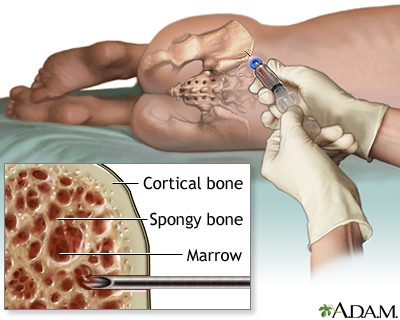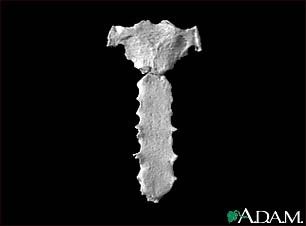Health Library
Bone marrow aspiration
Iliac crest tap; Sternal tap; Leukemia - bone marrow aspiration; Aplastic anemia - bone marrow aspiration; Myelodysplastic syndrome - bone marrow aspiration; Thrombocytopenia - bone marrow aspiration; Myelofibrosis - bone marrow aspiration
Bone marrow is the soft tissue inside bones that helps form blood cells. It is found in the hollow part of most bones. Bone marrow aspiration is the removal of a small amount of this tissue in liquid form for examination.
Bone marrow aspiration is not the same as bone marrow biopsy. A biopsy removes a core of bone tissue for examination.
Images


I Would Like to Learn About:
How the Test is Performed
Bone marrow aspiration may be done in the health care provider's office or in a hospital. The bone marrow is removed from your pelvic or breast bone. Sometimes, another bone is selected.
Marrow is removed in the following steps:
- If needed, you are given medicine to help you relax.
- The provider cleans the skin and injects numbing medicine into the area and surface of the bone.
- A special needle is inserted into the bone. The needle has a tube attached to it, which creates suction. A small sample of bone marrow fluid flows into the tube.
- The needle is removed.
- Pressure and then a bandage are applied to the skin.
The bone marrow fluid is sent to a laboratory and examined under a microscope.
How to Prepare for the Test
Tell the provider:
- If you are allergic to any medicines
- If you are pregnant
- If you have bleeding problems
- What medicines you are taking
How the Test will Feel
You will feel a sting and slight burning sensation when the numbing medicine is applied. You may feel pressure as the needle is inserted into the bone, and a sharp and usually painful sucking sensation as the marrow is removed. This feeling lasts for only a few seconds.
Why the Test is Performed
Your doctor may order this test if you have abnormal types or numbers of red or white blood cells or platelets on a complete blood count.
This test is used to diagnose:
- Anemia (some types)
- Infections
- Leukemia
- Other blood cancers and disorders
It may help determine whether cancers have spread or responded to treatment.
Normal Results
The bone marrow should contain the proper number and types of:
- Blood-forming cells
- Connective tissues
- Fat cells
What Abnormal Results Mean
Abnormal results may be due to cancers of the bone marrow, including:
- Acute lymphocytic leukemia (ALL)
- Acute myelogenous leukemia (AML)
- Chronic lymphocytic leukemia (CLL)
- Chronic myelogenous leukemia (CML)
Abnormal results may also be due to other causes, such as:
- Bone marrow doesn't make enough blood cells (aplastic anemia)
- Bacterial or fungal infections that have spread throughout the body
- Cancer of the lymph tissue (Hodgkin or non-Hodgkin lymphoma)
- A bleeding disorder called idiopathic thrombocytopenic purpura (ITP)
- Blood cancer called (multiple myeloma)
- Disorder in which the bone marrow is replaced by scar tissue (myelofibrosis)
- Disorder in which the bone marrow produces too many red blood cells (polycythemia) or platelets (thrombocytosis)
- Disorder in which not enough healthy blood cells are made (myelodysplastic syndrome; MDS)
Risks
There may be some bleeding at the puncture site. More serious risks, such as serious bleeding or infection, are very rare.
Related Information
AnemiaMyelofibrosis
Granulomatosis with polyangiitis
Hodgkin lymphoma
Cancer
Thrombocytopenia
Acute lymphoblastic leukemia (ALL)
Acute myeloid leukemia - adult
Vitamin B12 deficiency anemia
Folate-deficiency anemia
Chronic lymphocytic leukemia (CLL)
Chronic myelogenous leukemia (CML)
Immune thrombocytopenic purpura (ITP)
Waldenstrom macroglobulinemia
Pernicious anemia
Multiple myeloma
References
Bates I, Burthem J. Bone marrow biopsy. In: Bain BJ, Bates I, Laffan MA, eds. Dacie and Lewis Practical Haematology. 12th ed. Philadelphia, PA: Elsevier; 2017:chap 7.
Chernecky CC, Berger BJ. Bone marrow aspiration analysis -- specimen (biopsy, bone marrow iron stain, iron stain, bone marrow). In: Chernecky CC, Berger BJ, eds. Laboratory Tests and Diagnostic Procedures. 6th ed. St Louis, MO: Elsevier Saunders; 2013:241-244.
Choby BA. Bone marrow aspiration and biopsy. In: Fowler GC, ed. Pfenninger and Fowler's Procedures for Primary Care. 4th ed. Philadelphia, PA: Elsevier; 2020:chap 220.
Vajpayee N, Graham SS, Bem S. Basic examination of blood and bone marrow. In: McPherson RA, Pincus MR, eds. Henry's Clinical Diagnosis and Management by Laboratory Methods. 24th ed. Philadelphia, PA: Elsevier; 2022:chap 31.
BACK TO TOPReview Date: 4/29/2022
Reviewed By: Todd Gersten, MD, Hematology/Oncology, Florida Cancer Specialists & Research Institute, Wellington, FL. Review provided by VeriMed Healthcare Network. Also reviewed by David C. Dugdale, MD, Medical Director, Brenda Conaway, Editorial Director, and the A.D.A.M. Editorial team.
 | A.D.A.M., Inc. is accredited by URAC, for Health Content Provider (www.urac.org). URAC's accreditation program is an independent audit to verify that A.D.A.M. follows rigorous standards of quality and accountability. A.D.A.M. is among the first to achieve this important distinction for online health information and services. Learn more about A.D.A.M.'s editorial policy, editorial process and privacy policy. A.D.A.M. is also a founding member of Hi-Ethics. This site complies with the HONcode standard for trustworthy health information: verify here. |
The information provided herein should not be used during any medical emergency or for the diagnosis or treatment of any medical condition. A licensed medical professional should be consulted for diagnosis and treatment of any and all medical conditions. Links to other sites are provided for information only -- they do not constitute endorsements of those other sites. © 1997- 2022 A.D.A.M., a business unit of Ebix, Inc. Any duplication or distribution of the information contained herein is strictly prohibited.
